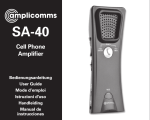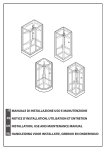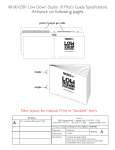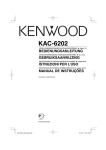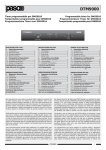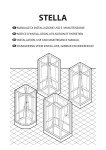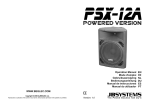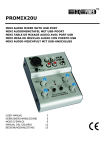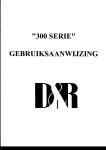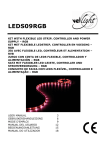Download "DISCOM 5" MANUAL - D&R Broadcast Mixing Consoles
Transcript
"DISCOM 5" MANUAL Discom 5 manual page 1 Geachte klant, Wij danken u hartelijk voor uw keuze en het vertrouwen dat u in ons produkt stelt. U deed een goede keus, dit produkt is ontworpen door en voor professionele gebruikers. Er is gebruik gemaakt van onze enorme "know how" in mengtafel technieken en dit gekombineerd met hoogwaardige komponenten geeft u de zekerheid van een lange gebruiksduur. Bovenstaande eigenschappen resulteren in een zeer betrouwbaar en bedrijfszeker eindprodukt. Uw discom 5 is een werkpaard onder de mixers. Deze gebruiksaanwijzing helpt u in het optimaal benutten van alle mogelijkheden die deze mixer in zich heeft. Mocht u nog vragen hebben dan kunt u zich te allen tijde tot onze dealers wenden en in uiterste nood tot ons D&R ELECTRONICA WEESP B.V. Rijnkade 15B 1382 GS WEESP-HOLLAND The Netherlands Phone: 0294-418 014 Fax: 0294-416 987 Website: http://www.d-r.nl E-mail: [email protected] Discom 5 manual page 2 DE INGANGS MODUUL De discom 5 is voorzien van 6 ruisarme "TRIPLE INPUT" ingangsmodules met de volgende mogelijkheden. * Twee lijningangen waarvan de "B" ingang geschikt is voor een optionele R.I.A.A. correctieversterker. * Een volledig gescheiden gebalanceerde microfooningang. * Een gain regeling. * Een driedelige toonregeling. * Een Cue toets voor voorafluistering in stereo. * Twee professionele 100mm faders en 4 professionele 60mm stereo faders. * Makkelijk vervangbare Crossfader tussen kanaal 3/4 en 5/6. BEDIENINGS ELEMENTEN VAN DE INGANGSMODULES. GAIN Dit is het engelse woord voor versterking. De "gain" past het inkomende ingangs signaal aan op het interne mixer signaal niveau. Dit is nodig om een optimale signaal ruisverhouding te realiseren. STEREO LINE. Deze ingangskeuze schakelaar kiest tussen de stereo A of B ingangen achterop uw discom 5 mixer. De B ingang kan voorzien worden van een R.I.A.A. correctievertsreker die nodig is voor weergave van platen. Bij het platen persen worden de lage tonen sterk verzwakt om meer muziek op de "zwarte schijf" te krijgen, tevens worden de hoge tonen extra versterkt. De R.I.A.A. correctieversterker nu versterkt de lage tonen en verzwakt de hoge zodat de oorspronkelijke verhoudingen tussen hoge en lage tonen weer hersteld wordt met het voordeel van lagere ruis en de mogelijkheid om meer nummers op een plaat te zetten. (Dit ter verduidelijking van de functie van de R.I.A.A. versterker). MIC INGANGSKEUZE SCHAKELAAR Deze schakelaar kiest in ingedrukte toestand direkt de gebalanceerde XLR microfoon ingang. De microfoon ingang is bestemd voor een laagohmige gebalanceerde dynamische microfoon Discom 5 manual page 3 TOONREGELING De ingangsmodule heeft een drievoudige toonregeling voor klankkleur correcties. De bas regeling heeft een speciale curve (een Bell curve) om te vermijden dat bij hoge volumes met veel bas informatie uw luidsprekers "opgeblazen" worden. Door bij het extra versterken van de lage tonen de extreem lage frekwenties onder de 40Hz weer minder te laten versterken bereiken wij een goed vol laag zonder extra belasting van uw luidsprekers. AUX SEND De Aux send is een regelbare uitgang per kanaal die te vergelijken is met de funktie van de fader. Deze Aux send stuurt eveneens een signaal of deel daarvan naar een aparte uitgang. Aux sends worden gebruikt voor het sturen van signalen naar effect apparatuur zoals galm of delay processors. De Aux is van fabriekswege uit zo ingesteld dat zijn signaal afgetakt wordt na de fader. Iedere faderbeweging zal ook invloed hebben op de hoeveelheid signaal dat op de Aux uitgang terecht komt. De Aux send kan ook "pre fader" (nu post fader) gezet worden door uw dealer. Indien de Aux send pre fader is dan is de Aux send optimaal te gebruiken voor monitor doeleinden. CUE DRUKTOETS De CUE druktoets geeft u de mogelijkheid om het microfoon of lijnsignaal vooraf in stereo te beluisteren alvorens het signaal in de mix te schuiven. Het gekozen signaal hoort u automatisch in de koptelefoon zodra de Cue toets geactiveerd is. FADERS Dan volgt als laatste op het kanaal front de kanaalfader (schuifpotentiometer). Deze schuifknop zorgt voor de uiteindelijke mixage van uw ingangssignalen. Kanaal 1 en 2 hebben 100mm faders en kanaal 3/4/5/6 hebben 51 mm faders om razendsnel mixen van twee of meer bronnen te realiseren. Deze laatste 4 kanalen zullen voornamelijk door CD spelers en cassettedecks gestuurd worden en een snel in en uitfaden gaat veel eenvoudiger via korte faders dan via lange. CROSSFADER Onder de korte faders zit de crossfader. De crossfader biedt u de mogelijkheid om signalen tussen kanaal 3/4 en kanaal 5/6 soepel in elkaar over te laten vloeien zonder volume verschil te creëren door een speciale "cross" curve in de discom 5. INGANGSCONNECTORS Iedere ingang beschikt over drie gescheiden aansluitbare ingangen plus een start connector die later beschreven wordt. Onder op het connector paneel zit een 3 polige XLR steker, bestemd voor microfoons. Een microfoon is een instrument dat acoustische signalen in electrische signalen omzet zonder enige versterking (in de meeste gevallen). Deze minuscuul kleine signalen moeten versterkt worden zonder storing en/of ruisbijdrage door het mengpaneel, hiervoor is de discom 5 uitstekend uitgerust. Discom 5 manual page 4 INGANGSCONNECTORS In plaats van 1 gevoelige aansluiting aan de ingang heeft de discom 5 twee gevoelige aansluitingen per kanaal (gebalanceerd). Dit nu onderscheidt de discom 5 van de meeste andere discotheek mixers. Het is mogelijk, en zelfs een professionele eis, de twee draden uit uw microfoon, welke binnen in de afscherming van de microfoonkabel zitten aan te sluiten op de gebalanceerde ingangen op de volgende wijze. Een ader op punt 2 van de XLR connector (De grote ronde connector met drie bussen) en een ader op punt 3 , punt 1 is de aarde welke aangesloten dient te worden op de mantel van de kabel die rondom de twee binnen aders ligt van uw microfoonkabel. Wat heeft dit nu voor voordelen. De op deze wijze aangesloten microfoonkabel is volkomen ongevoelig voor storingen van buiten af. Indien u condensator microfoons heeft (op een ander principe ontworpen microfoons) dan is het mogelijk (zie options) om een phantome voedingsspanning van 15 volt te genereren op pin 2 en 3 van de XLR plug. (Let op niet alle condensator microfoons hebben genoeg aan 15 volt om te werken). Indien er 48 volt nodig is raden wij u aan kontakt op te nemen met uw dealer of een externe phantome voeding uit onze signaal processor reeks aan te schaffen. STEREO CINCH LIJN AANSLUITINGEN De stereo lijningangen (Line staat op de achterzijde gedrukt) dienen als volgt aangesloten te worden. De signaal draad dient op de pen van de cinch connectoren (ook wel tulp connector genoemd) aangesloten te worden. U dient er tevens op te letten dat het signaal niveau zich bevindt tussen -20dB en +20dB om een volledige uitsturing van uw Discom 4 te waarborgen. Slechts dan ontstaat er een optimale signaal ruisverhouding. STARTSWITCH Deze connector is i.v.m. universaliteit van onze mengtafels niet aangesloten bij de discom 5. Er kan eventueel als optie een faderstart aangebracht worden in uw mengtafel waarbij de startconnector gebruikt wordt voor aansluiting. SLUIT NOOIT 220 VOLT AAN OP DE START JACK Sluit alleen laagspanning op de schakelkontakten aan met als maximum 24 volt bij 500 mA. Neem hierover in twijfel gevallen kontakt op met uw dealer. Discom 5 manual page 5 SPECIALE OPTIES IN UW discom 5 KANALEN. Op de printplaat van uw discom 5 zijn verschillende jumpers (kleine overbruggingen) geplaatst om een aantal functies anders te laten verlopen dan de fabrieks instellingen op dit moment. Wij raden u aan dit door uw dealer uit te laten voeren indien u een van de hieronderstaande veranderingen wenst door te voeren. Te beinvloeden mogelijkheden zijn: 1. R.I.A.A. correctie versterker plaatsen op jumpers J12 en J13. 2. Laag af filter activeren op microfoon ingang via jumper J3. 3. 15 volt Phantome voeding activeren via jumper J15. 4. Aux send pre of post zetten via jumper J6 (fabrieks setting is post) 5. Start jack de-activeren door jumper J11 (1-2) 6. Monitor mute activeren door ON toets, jumper J11 (3-4) (voor radio doeleinden) MASTER SECTIE De discom 5 master sectie is het deel waar alle signalen uit de individuele kanalen zoals de links/rechts signalen, master Aux, en Cue uitgangen samen komen. We zullen alle individuele functies, die voorzien zijn van heldere leds, per stuk bespreken. LEDBAR METERS De master heeft grote 21 segments ledbars (VU meters) die een duidelijke uitlezing geven van de uitgaande signalen. De aanspreektijd reactietijd (attack) is gelijk aan de teruglooptijd (release of decay), dit zijn internationaal vastgelegde normen voor VU meters, te weten 300mSec per 20dB signaal verloop. Deze aanwijzing hebben wij verkozen boven de peak aanwijzing die elke peak langer dan 1 mSec aangeeft. Een peak aanwijzing is zeer geschikt voor digitale apparaten waarbij oversturing zeer onaangename bijgeluiden geeft. Een VU aanwijzing geeft een meer realistischer indruk van het geluidsniveau op een soortgelijke wijze als onze oren die ervaren. De ledbar is onderverdeeld in een aantal groene, gele en rode leds. Het groene gedeelte is het "veilige"gedeelte, dit gedeelte moet zeker oplichten om een goede uitsturing van de electronica te waarborgen. De gele leds geven het "werkgebied" van de audio aan, een regelmatig oplichten van de gele leds zorgt voor een goed signaal niveau. De rode leds geven het begin aan van het gevaren gebied, een signaal mag af en toe het rood in gaan maar niet konstant, dit om vervorming te vermijden. De uitgang van de mixer ligt 4 dB hoger dan het interne signaal niveau. Dit betekent dat de mixer uitgang +4dB signaal geeft (1.22 volt) indien de laatste groene led aangaat. Dit niveau is ruim voldoende om elke versterker voluit te sturen. Discom 5 manual page 6 MASTER MONO TOETS Deze toets maakt van het stereo signaal een mono signaal op beide hoofduitgangen. Deze toets is erg handig om een geluidsinstallatie goed in balans af te regelen, of bij het ontbreken van een van de stereo signalen toch de beide luidsprekerboxen of uitgangen voluit te sturen. AUX SEND De Aux send master regelt het totaal uitgaande signaal van alle individuele Aux sends in de ingangskanalen. AUX CUE De Aux Cue laat horen welke kanalen signaal naar de Aux master sturen. Het is wel nodig om de Aux master open te zetten (de Cue is hier post fader), dit is dus afwijkend van de kanalen. Maar om een juist inzicht te krijgen van het uitgaande signaal niveau op de ledbars, is het nodig dit zo te ontwerpen. U kunt nu dus met de master Aux regelaar het juiste niveau naar een aangesloten randapparaat sturen. MONITOR De monitor regelaar wordt gevoed uit de links/rechts master, voor de master stereo faders. Dit is dus een aparte stereo uitgang om nog een apparaat dan wel geluids systeem aan te sturen. FOLLOW PHONES TOETS Deze toets (met led) is eigenlijk een ingangskeuzeschakelaar voor de monitor uitgang. In plaats van de monitor te voeden met het links/rechts signaal is het ook mogelijk om de ingang van de monitor te voeden met het signaal dat in de koptelefoons terecht komt. Deze funktie wordt vaak gebruikt door DJ's die zonder koptelefoon willen werken. 2 TRACK Deze toets vervangt het inkomende master links/rechts signaal in de koptelefoon door een extern aangesloten stereo signaal via de 2 track ingang, gevoeligheid ligt op -10dBv (300mV). Let op!, het Cue systeem zal ook de 2 track inputs onderbereken indien het geactiveerd wordt. AUX RETURN Deze stereo ingang, (met eigen stereo cue afluistering) is bedoeld om galm apparatuur op aan te sluiten. Deze aux return staat rechtstreeks aangesloten op de centrale links/rechts mix versterkers. U kunt dus ook hierop een andere mixer aan sluiten zonder verlies van ingangskanalen. Discom 5 manual page 7 CUE AUX RETURN Deze stereo Cue toets geeft de mogelijkheid vooraf te luisteren naar binnenkomende signalen via de stereo Aux return ingangen. BALANCE De balance regelaar behoeft een wat uitgebreidere uitleg. Zoals op het front te zien is kunt u de balans regelen tussen de stereo Cue signalen en de master link/rechts uitgangs signalen in de koptelefoon uitgang. Ook de split toets heeft hierop invloed, maar dat bespreken we later nog. Zonder de split toets in te drukken is het nu mogelijk de balans te regelen tusen het Cue signaal en het uitgangssignaal. Op deze wijze houdt u altijd controle over het uitgaande signaal indien een Cue toets geactiveerd is. De balans tussen deze twee signalen kan naar smaak ingesteld worden. SPLIT Indien nu de SPLIT toets gedrukt wordt onstaat de volgende afluister situatie. In het linker oor hoort u nu het opgetelde Cue signaal in mono en in het rechter oor het opgetelde links/rechts signaal (pre fader). De balance regelaar heeft nu geen invloed op deze verhouding. PHONES De phones uitgang (op het front) met volume regelaar heeft een automatische stereo ingangskeuze schakelaar die geactiveerd wordt door het CUE systeem van de discom 5. Normalerwijze hoort u op deze uitgang het stereo links rechts signaal, echter zodra er een Cue toets ergens in de mixer geactiveerd wordt, wordt het links/rechts signaal vervangen door dat specifiek geselecteerde Cue signaal. Wij raden aan koptelefoons te gebruiken welke geen lagere impedantie hebben dan 400 Ohm. Een 8 ohm koptelefoon zal bij het opdraaien van het volume snel vervorming gaan geven vanwege zijn zeer laagohmige belasting (dezelfde belasting als luidsprekers en de discom 5 is geen eindversterker). Hoewel dit alléén merkbaar is in de koptelefoonuitgang en niet op de master uitgangen, is het aan te raden deze situatie te vermijden. MASTER FADER De master fader van de discom 5 is een stereo 51mm fader die het totaal van het uitgangssignaal regelt. Discom 5 manual page 8 MASTER CONNECTORS Het master achterpaneel bestaat uit 12 Cinch(tulp) connectors en 2 male XLR connectors waarop alle in en uitgaande signalen aangesloten worden. Verder vindt u hier de 220 volt netaansluiting met ingebouwde netzekering en een aarde aansluiting (ground). TAPE OUTPUTS Indien u van links naar rechts de connectors volgt komt u als eerste de Tape output connectors tegen. Zowel de linker als de rechter Tape uitgang is dubbel uitgevoerd voor het aansturen van meerdere opname decks. Het uitgangsniveau is -10dBV (300 mV) en het signaal is onafhankelijk van de positie van de master fader. AUX RETURN Rechts van de tape connectors ziet u de Aux return connectors. Dit zijn de ingangen die geregeld worden door de Aux return regelaar op de master sectie en die direct doorverbonden zijn naar de links/rechts som versterkers. Op deze ingangen kunnen effect apparaten zoals galm/reverbs aangesloten worden. Deze ingang is ook geschikt voor het aansluiten van apparatuur die geen toonregeling nodig heeft. Het ingangsniveau moet minimaal -10dBv (300mV) zijn. AUX OUTPUTS De Aux output connectors zijn twee parallel geschakelde uitgangs connectors die het signaal doorgeven wat naar de Aux master gestuurd is. Het niveau is hier +4dBu (1.55 volt). Deze uitgang is bedoeld voor het aansturen van galmapparatuur of monitor boxen. Bij het gebruik van de Aux uitgang als monitor is het raadzaam om de Aux send per kanaal op pre fader te laten zetten door uw dealer. 2 TRACK INPUTS Deze Cinch inputs zijn bestemd voor het laten weergeven van eventueel opgenomen signalen op uw tapedeck, DAT recorder, of anderzins. Het signaal komt direct in de koptelefoons indien de 2Track toets op het front geactiveerd is. Het ingangs level dient minimaal -10dBV (300mV) te zijn. MASTER OUTPUTS De master outputs zijn uitgevoerd op male XLR stekers in een Ground compensated aansluitings configuratie. U kunt op deze uitgangen elke eindversterker aansluiten met gebalanceerde ingangen. De Ground Compensated uitgangen zorgen voor een volledig gebruik van de voordelen van gebalanceerde in en uitgangen zoals optimale stoor onderdrukking voor brom instrooing van buitenaf. Het niveau is hier +4dBu (1.55volt) GROUND CONNECTOR Deze connector is bedoeld voor aarde aansluiting van draaitafels en/of als centraal aardpunt in een komplexe installatie. Discom 5 manual page 9 NET ENTREE MET ZEKERING De net entree is uitgevoerd als eurosteker met ingebouwde zekering. De discom 5 is geschikt voor spanningen tussen 210 volt en 230 volt (de netspanning waar we langzaam naar toegaan in dit land). De ingebouwde zekering is 1 Ampere traag. Vervang nooit deze zekering door een hogere waarde, het kan bij interne sluiting brand veroorzaken. IN GEBRUIK STELLING - Sluit een eindtrap/recorder/zender aan op een van de left/right MAIN XLR outputs. - Sluit een hoog ohmige koptelefoon aan op de "phones" jack op het front. - Verbind uw microfoon als omschreven met de discom 5. - Zo ook de draaitafels, alsmede de tapedecks en jingle machine. *Nu uw hele installatie staat aangesloten, volg de onderstaande inregelprocedure*, - Zet de PHONES volume regelaar op ongeveer "12 uur". - Zet alle gainknoppen en master volume regelingen linksom. - Zet alle toonregelingen op " 12 uur" . - Zet alle faders naar beneden. - Zet alle druktoetsen zo dat ze korresponderen met de aangesloten bronnen. - Voor microfoons alleen de rode mic toets omlaag. - Voor cassette decks op ingang A alle toetsen omhoog. - Voor draaitafels de STEREO LINE toets ingedrukt (er dient dan wel een R.I.A.A. correctie versterker op de print gemonteerd te zijn) - Sluit een netsnoer aan op de mixer. - Schakel de voeding in via de netschakelaar waarna de onderste leds van de ledbar oplichten. INREGELING INGANGSMODULE Druk de CUE toets van het kanaal dat u wilt gebruiken. Draai nu de "GAIN" knop langzaam naar rechts, totdat u het ingangs signaal hoort en op de ledbar ziet. U kunt bij voldoende uitsturing op de ledbar (signaal komt af en toe in het gele gedeelte) het PHONES volume aanpassen aan wat u zelf aangenaam vindt. Het nu gehoorde signaal moet regelmatig door de "0"dB led heen bewegen bij aanwezig ingangssignaal. De ledbar reageert op het gemiddelde niveau (VU aanwijzing) en is zo afgeregeld dat een uitgangs niveau van +4 dBu (1.22 volt) een uitlezing geeft van 0 dB op de Led bar. U kunt door verdraaing van de toonregelingen een aangenamer klankkleur realiseren. Kontroleer na de toonregel-instellingen nogmaals het niveau via de ledbar. Schakel nu de CUE toets uit. Druk nu de ON toets in waardoor u het signaal doorverbindt met de fader. Schuif nu de fader omhoog naar de "8" positie (het gebied met meerdere lijnen) en schuif langzaam de master volume fader omhoog totdat de ledbars wederom regelmatig door de " 0" tot maximaal +8 dB positie heen oplichten . Verdere volume instellingen moet u realiseren op de eindversterkers/tapedecks. Discom 5 manual page 10 INREGELING INGANGSMODULE Een goede gewoonte is om bij volledig opgeschoven master faders een goede uitsturing te realiseren op de ledbars en vervolgens uw eindverkers zo in te regelen dat zij het gewenste volume geven wat nodig is voor de job. De andere inputs worden op een identieke wi jze ingeregeld via de CUE toets en de gainregeling. Zaken om op te letten. Zorg ervoor dat de discom 5 niet opgesteld wordt in de buurt van zware transformatoren zoals aanwezig in eindversterkers. Dit kan brom veroorzaken door instrooing, ondanks de plaatstalen kast en het dikke front. In geval van vragen leest u de gebruiksaanwijzing nogmaals door en tracht bij storingen door logisch nadenken te lokaliseren waar de storing zich bevindt alvorens ongerust uw dealer op te bellen. INBOUW INSTRUCTIES VOOR R.I.A.A. CORRECTIE PRINT. De discom 5 heeft de mogelijkheid om elk kanaal geschikt te maken voor pick-up elementen welke een speciale correctie curve nodig hebben. De stereo R.I.A.A. correctieversterker die op uw verzoek hierbij geleverd wordt kan eenvoudig door uzelf worden ingebouwd in het door u gekozen kanaal. Zorg allereerst dat de netstekker uit het stopkontakt verwijderd is! Verwijder met een kruiskop schroevedraaier de drie boutjes aan de voorzijde in het front van het mengpaneel. Leg vervolgens het mengpaneel op zijn kop op een zachte ondergrond (zodat de knoppen niet beschadigen). Verwijder nu de drie boutjes aan de onderkant van uw mengpaneel en de twee boutjes aan de zijkant van de kast. U kunt nu de omkasting van de mixer verwijderen door deze naar voren weg te trekken. U ziet nu de zes kanaal printen met op iedere print direkt achter de ingangs jacks twee stekkertjes 45 mm van elkaar geplaatst in het RIAA optievlak, waarvan een (J12) voorzien is van twee jumpers, dit zijn kleine kortsluit brugjes. Verwijder de twee kortsluitbrugjes en plaats het R.I.A.A. printje met de komponenten naar de print toe gericht op de twee stekkertjes op dat kanaal waar u de korrektie versterker wenst. Er is maar een juiste manier mogelijk om dit te doen. Let op dat alle vier de pennen in de busjes vallen en druk de print zover mogelijk naar beneden. Dit is alles wat er nodig is om de discom 5 geschikt te maken voor pick-ups. Zet vervolgens de bodem weer vast in omgekeerde volgorde van het uiteennemen. Wij wensen u veel plezier met uw nieuwe aanwinst. D&R service department Discom 5 manual page 11 Hieronder volgt nog een opsomming van belangrijkste technische gegevens. MIC input XLR aansluiting symmetrisch ingangsimpedantie 2 kOhm. pin 2-in faze. pin 3-uit faze. pin 1 -aarde. gevoel igheid - 60 dBu. LIJN A/B input Cinch (tulp) connectors voor links en rechts. Gevoeligheid -20 dBu tot +20dBu. Disc inputs (Line B) (Alleen met optionele R.I.A.A. correctie versterker). 47 kOhm 0, 5 mv tot 10 mV. START remote (optional) Stereo jack waarbij tussen aarde (echter vrij van de audio aarde) en ring geschakeld wordt. LET OP!!! Niet geschikt voor 220 volt! MASTER OUTPUT XLR male aansluiting voor links en rechts. pin 2-in faze. pin 3-uit faze. pin 1 -aarde. uitgangsniveau +4 dBu (1.55volt)/100 Ohm . TAPE Cinch aansluiting voor links en rechts. -10dBv (300mv) uitgang / 1kOhm. Afscherming-aarde. AUX RETURN Cinch aansluiting voor links en rechts. -10dBv (300mv) ingang / 10kOhm. Afscherming-aarde. 2-TRACK INPUT Cinch aansluiting voor links en rechts. -10dBv (300mv) ingang / 100kOhm. Afscherming-aarde. AUX OUTPUTS Cinch aansluiting, (parallel geschakeld) +4dBu (1.22 volt) 100 Ohm. Afscherming-aarde. MONITOR OUTPUT Cinch aansluiting voor links en rechts. +4dBu (1.22 volt) 100 Ohm. Afscherming-aarde. PHONES Stereo en alleen geschikt voor koptelefoons van 400 ohm en hoger. Discom 5 manual page 12 TECHNISCHE SPECIFICATIES INPUTS Mic input balanced 2 kOhm. Mic noise -122dBr (A-weighted). Gevoeligheid: -70dB min, 0dB maximum. Line inputs: unbalanced, 10kOhm, Cinch gain range 40dB. Phono inputs: unbalanced, 47kOhm, 1-10 mv. 2 Track return: -10dBv at 10kOhm. Aux return: -10dBv at 10kOhm. OUTPUTS Left/Right/Monitor/Aux: +4dBu (1.55volt) at 47 Ohm. Tape output: -10dBv at 1kOhm. Headphone: 400-600 Ohm, 500mw. EQUALIZER OVERALL High: +/- 12 dB at 12kHz shelving curve. Mid: +/- 12 dB at 1 kHz bell curve. Low: +/- 12 dB at 60 Hz bell curve. Frequency response 10-60.000 Hz (+/- 0.5dB). Distortion: <0.009% max at 1 kHz. Dimensions: 483x356x95 mm (8HE). Weight: 9 kg. Wij wensen u een zeer langdurig en creatief gebruik van dit produkt van D&R Electronica Weesp b.v. Rijnkade 15B 1382 GS WEESP The Netherlands Phone: 0294-418 014 Fax: 0294-416 987 Website: http://www.d-r.nl Discom 5 manual page 13 CLARATION OF CONFORMITY Manufacturers Name: D&R Electronica Weesp b.v. Manufacturers Address: Rijnkade 15B, 1382 GS Weesp, The Netherlands declares that the product DISCOM 5 series conforms to the following product specifications: EMC: NEN-EN 55103-1 NEN-EN 55103-2 NEN-EN 55013-1 1995 1995 1994 Supplementary Information: The products herewith complies with the requirements of the EMC Directive 89/336/EEC (1989) as amended by the CE Marking Directive 93/68/EEC (1993). D&R Electronica Weesp b.v. Rijnkade 15 B 1382 GS WEESP The Netherlands President of Engineering . Discom 5 manual page 14 PRODUCT SAFETY This product is manufactured with the highest standards and is double checked in our quality control department for reliability in the "HIGH VOLTAGE" section. CAUTION Never remove any panels, or open this equipment. No user servicable parts inside. Equipment power supply must be grounded at all times. Only use this product as described, in user manual or brochure. Do not operate this equipment in high humidity or expose it to water or other liquids. Check the AC power supply cable to assure secure contact. Have your equipment checked yearly by a qualified dealer service center. Hazardous electrical shock can be avoided by carefully following the above rules. EXTRA CAUTION FOR LIVE SOUND Ground all equipment using the ground pin in the AC power supply cable. Never remove this pin. Ground loops should be eliminated only by use of isolation transformers for all inputs and outputs. Replace any blown fuse with the same type and rating only after equipment has been disconnected from AC power. If problem persists, return equipment to qualified service technician PLEASE READ THE FOLLOWING INFORMATION Especially in sound equipment on stage the following information is essential to know. An electrical shock is caused by voltage and current, actually it is the current that causes the shock. In practise the higher the voltage the higher the current will be and the higher the shock. But there is another thing to consider and it is resistance. When the resistance in Ohms is high between two poles, the current will be low and vica versa. All three of these; voltage, current. and resistance are important in determining the effect of an electrical shock. However, the severity of a shock primarily determined by the amount of current flowing through a person. A person can feel a shock because the muscles in a body respond to electrical current and because the heart is a muscle it can affect, when the current is high enough. Current can also be fatal when it causes the chest muscles to contract and stop breathing. At what potential is current dangereous. Well the first feeling of current is a tingle at 0.001 Amp of current. The current between 0.1 Amp and 0.2 Amp is fatal. Imagine that your home fuses of 20 Amp can handle 200 times more current than is necessary to kill. How does resistance affect the shock a person feels. A typical resistance between one hand to the other in "dry" condition could well over 100,000 Ohm. Discom 5 manual page 15 If you are playing on stage your body is perspiring extensively and your body resistance is lowered by more than 50%. This is a situation in which current can easily flow. Current will flow when there is a difference in ground potential between equipment on stage and in the P.A. system. Please do check if there is any potential between the housing of the mikes and the guitarsynth amps, which will be linked by your body on stage. Imagine, a guitar in your hand and your lips close to the mike! A ground potential difference of above 10 volts is not unusual, in improperly wired buildings it can possibly be as high as 240 volts. Allthough removing the ground wire sometimes cures a system hum, it will create a very hazardeous situation for the performing musician. Always earth all your equipment by the grounding pin in your mains plug. Hum loops should be only cured by proper wiring and isolation input/output transformers. Replace fuses always with the same type and rating after the equipment has been turned off and unplugged. If the fuse blows again you have an equipment failure, do not use it again and return it to your dealer for repair. And last but not least be carefull not to touch a person being shocked as you, yourself could also be shocked. Once removed from the shock, have someone send for medical help inmediately Always keep the above mentioned information in mind when using electrically powered equipment. See English version of discom 5 manual on next pages. Discom 5 manual page 16 ENGLISH TRANSLATION OF discom 5 MANUAL We like to thank you for purchasing our new discom 5 mixer and are certain that it will give you years of reliable joy while mixing with this D&R product. The discom 5 is equipped with 6 low-noise mic balanced input modules. with the following features * Two line inputs with optional R.I.A.A. pluggable pre-amp * A professional low noise balanced mic pre-amp * A gain control * A three band equalizer * A stereo CUE switch for pre fade listening * Two 100 mm professional faders and four 51mm professional faders. * Crossfader between channel 3/4 and 5/6 INPUT MODULES Every module has three selectable inputs. There is a microphone input on XLR, and two stereo line inputs on cinch connectors and a Start connector. The mic input is a professional balanced input circuit, this means that you now have a studio-class microphone-channel at your disposal. A microphone is an instrument that turns acoustical signals in electrical ones, without any amplification (in most cases). These very small signals have to be amplified without any noise and interference from the mixing table. The Discom 5 is equipped for this purpose. Instead of one sensitive connection at the input channel, the discom 5 has 2 connections per channel (balanced). This is a major difference between the Discom 5 and other disco mixers. It is now possible to connect the 2 wires in your microphone cable to the balanced input as follows: - One wire to pin 2 of the XLR connector. - The other wire to pin 3 of the XLR connector. - The shielding on the remaining pin 1 of the connector. What are the advantages of this system ? A microphone cable connected in this way is completely insensitive for outside interference. STEREO LINE The stereo line inputs need to be connected as follows. The left cinch connector is the left input and the right Cinch connector is the right input. The shield needs to be connected to the ground. The START switch has two active connections to be wired. The tip and ring are shorted when the ON switch or optional faderswitch is activated. The controls of the input modules have the following functions. Discom 5 manual page 17 GAIN With the gain, the source level is adjusted to the internal mixer level. The module has a three band equalizer to control the high and low frequencies individually in bad acoustic environments. Below the equalizer you will find the stereo CUE switch (Pre Fader Listening), this switch gives you the possibility to check the signal before you mix it with your other signals . The ON switch is used to start turntables and cassette decks as well as jingle machines. Last control is the 100mm channel fader, this is the actual control to mix the signals. Channel 3 to 4 have short travel faders to be able to do fast mixing. CROSSFADER Below the short travel faders you can find the crossfader enabling you to cross signals between channels 3/4 and 5/6 without any level changes. This is due to a sspecial curve INPUT CONNECTORS On the back of your Discom 5 you find six connectors, one has already been discussed, that was the balanced or symmetrical microphone input, the other two are the stereo line inputs. On line B you can buy an optional available R.I.A.A. correction amp to be able to mix turn tables. The level can be set by the gain control to match with every available cartridge. There is a stereo "CUE " switch on the front to cue the incoming signal. START CONNECTOR The start connector is not connected in the Discom 5 for reasons of production. For your information, we also use the backpanel for Clubmate mixers which do have an ON switch. Also the older model Discom 4 had an ON switch, but customer feedback told us that DJ’s were not very pleased with the ON switch. It has the danger of suddenly muting the sound when hitting this switch instead of the CUE switch. *NEVER CONNECT MAINS TO THIS REMOTE-JACK* Connections on the START connector can only be made with a maximum of 24 Volts by 500 mA. Please contact your dealer in case of doubt. SPECIAL AVAILABLE OPTIONS IN YOUR DISCOM 5 MIXER On the input PCB of your Discom 5 are several jumpers that can be changed to enable different configurations of the channel settings. We advice you to have this done by your local dealer if the need arises. The following jumper settings can be selected: 1. R.I.A.A. correction amp on Jumper J 12 and J 13. 2. Low cut filter on Mic input only through Jumper J 3. 3. 15 volt phantome power via Jumper J 15. 4. Aux send pre or post selectable via Jumper J6 (post is default). 5. Start jack de-activating by Jumper J 11 (1-2). 6. Monitor Muting active by On switch via Jumper J 11 (3-4) (for broadcast). Discom 5 manual page 18 THE MASTER SECTION The Discom 5 master section houses all the controls for the summing amps and master inputs such as Aux return, 2-Track return, and master outputs. All individual functions we shall describe here. LEDBAR METERS The master section has two large 21 segment meters (VU meters) reading all in and outgoing signals. The attack and release timeconstants are conform international standards, being 300mSec for attack and decay. The green area in the ledbar is the safe area, and the yellow area the range that normally would be on when properly aligned. The output of your discom 5 is +4dBu (1.22v) when the last green led is on. MASTER MONO SWITCH This switch turns the stereo signal into mono for both maain outputs. It is a convenient way of balancing the left right signal before going to stereo. Also when one side of the stereo signal is missing the mono switch is very helpful. AUX SEND The Aux send master controls the sum of all the individual Aux send signal coming from the input channels. AUX CUE The Aux cue redirects the master output signal and ledbar indication to the Aux output that gives you the total outgoing signal of the Aux master. It is necessary to turn the master control up to have an outgoing signal. MONITOR The monitor control is fed by the master outputs pre master fader. It is an extra stereo output for another sound system or recording device. FOLLOW PHONES This switch actually is an input selector for the monitor output. Instead of listening to the main outputs, it is also possible to listen to the phones output. This feature is often used by DJ's that do not want to use headphones. 2-TRACK This switch replaces the incoming left/right signal or Cue signal by an externally connected source on the 2 track input connectors. Its sensitivity is -10dBv (300mV). Note: The Cue system will interrupt the 2 track when activated. Discom 5 manual page 19 AUX RETURN This stereo input is intended to be used for returning reverbs. This input is directly connected to the stereo main mix buss and can be used to connect other mixers without loosing valuable input channels. CUE AUX RETURN This switch enables you to stereo pre listen to an incoming Aux return signal. BALANCE The balance knob controls the balance between the main stereo output and the stereo Cue signal when selected. Note: The split switch de-activates the balance control. With the balance control anywhere between Cue and L/R you always have control over the main output signal even when a Cue switch is activated. SPLIT When the split function is activated the following listening situation is created. The left side of the phones output gives the summed Cue signal and the right output gives the summed left/right signal (pre fader). The balance control has no influence on this configuration anymore. PHONES The phones output (located on the frontpanel) has an automatic input selector. Normally the left/right output is heard until a Cue switch is activated anywhere in the console that inmediately takes over the left/right signal. The ledbar switches accordingly with this action. We advice you to use headphones with an input impedance not lower than 400 Ohm to avoid distortion. An 8 Ohm headphone will produce lots of distortion when cranking up the level due to its low impedance load. It is a load equivalent to the load that loudspeakers normally present to power amps and as you know the discom 5 is no power-amp, sorry. MASTER FADER The Discom 5 master faders are 60mm models controlling both left and right signals. MASTER CONNECTORS The master connector panel houses 12 Cinch connectors and 2 male XLR connectors where all interfacing takes place. Furthermore the mains connector with integrated fuse holder is located in this section. A ground terminal completes the back panel connector section. TAPE OUTPUTS The first connectors on the left are the tape output connectors. Both left and right connectors are paralelled for connecting more than one tapedeck or DAT recorder. Output level is -10dBv (300mV). Discom 5 manual page 20 AUX RETURN Right from the tape connectors you see the Aux return connectors. These inputs are controlled by the Aux return knob. The signal is directly connected to the master main mix busses. You can connect reverb returns or other stereo signals without using any input module. The input level should -10dBv as a minimum. AUX OUTPUTS The aux outputs are two paralleled Cinch connectors giving the signal coming from the aux sends in the channels. The level is +4dBu (1.22 volt). You can connect inputs from reverbs to this Cinch connector or use it as a monitor output, when you have jumpered the Aux send in the channels pre fader. 2-TRACK INPUTS These inputs are intended to return stereo machines in the monitor section. Signals from DAT machines or tapedecks. The level needs to be -10dBv (300mV) as a minimum for optimum signal to noise. MASTER OUTPUTS The master outputs are on male 3 pin XLR connectors in a ground compensated arrangement. Ground compensated means that all advantages of balancing are maintained when connected to a balanced input of a power amp or professional tapedeck or DAT recorder. The output level is +4dBu (1.22 volt). GROUND CONNECTOR This terminal is intended for grounding phono players or it is to be used as central ground pin is complex set-up. MAINS CONNECTOR The mains inlet is a euro type connector with built in fuse. Your discom 5 can accept voltages between 210 volts and 230 volts 50/60Hz. The built in fuse is a slow blow type of 1 Amp. never replace this fuse by higher values. In case of 115 volt local power the value of the fuse needs to be increased to 2 Amps. Discom 5 manual page 21 SETTING UP ROUTINES - Connect a power-amp, recorder or transmitter to the left/right outputs. - Connect a high impedance headphone to the "phones"-jacks on the front. - Connect the microphones as described. - Act like wise with turntables, tapedecks and jingle machines. - Now that everything is connected, follow the adjustment procedure. (Note; for mics , only activate the red mic switch, for line level on input all switches in the up position) - Put on your headphones and turn the headphone-volumecontrol to "12 o'clock" position. - Turn all the gain-controls and the master-control to the left. - Set all equalizer-controls to the "12 o'clock"position. - All pushbutton-switches should be in the up position. - Switch on the power-supply, the first led in the led bar should be on. SETTING UP AN INPUT CHANNEL - Depress the CUE switch in a channel that is connected to a source. - Now slowly turn the GAIN control clockwise until you hear and see the input signal on the ledbars in the master section. - You can change the input sound by adjusting the equalizer-section. If you have adjusted the equalisation, once again check the level on the ledbar, because increasing specific parts of the frequency spectrum can easily ad more gain to the signal. - The ledbar indication has to be between 0 dB and +6 dB (the yellow area) to get a proper level on amplifiers or tape machines. - The ledbar is a VU meter indicating the absoluut level that enters the console. It is calibrated to indicate 0 dB on the scale corresponding with a +4dBu output level. - Release the CUE switch so the ledbar now reads the output signal again. - Now fade to the "8" position screened alongside the channel faders and fully turn up the master fader. Further volume adjustments have to be realized on the power-amp. - The other inputs are likewise ad justed, using the "CUE" switches to pre fader listen the connected sources and usage of the the input gain for precise adjustments. Be carefully not to place the Discom 5 near heavy power transformers, as used in power amps etc, this may couse hum, inspite of the thick metal case. Discom 5 manual page 22 WIRING SUMMARY OF ALL CONNECTORS MIC INPUTS XLR connector balanced impedance 2 kOhm. sensitivity -60dBu. Pin1=ground. Pin2=hot (in phase). Pin3=cold (out of phase). LINE A/B Cinch connector, sensitivity -20dBu to +20 dBu. sleeve =ground. DISC INPUTS On B inputs only when optional R.I.A.A. pre-amp is installed. 47kOhm, 0.5 mV to 10 mV. START REMOTE Stereo jack switched between sleeve and ring by start switch. NOT FOR 110/220 VOLT SWITCHING!!!!!!! MASTER OUTPUT CONNECTORS MAIN XLR male connector for left and right. pin 1 = ground. pin 2 = in phase. pin 3 = out of phase. output level = +4dBu/100Ohm. TAPE Two cinch connectors for left and right. -10dBv (300mV) /10kOhm. Sleeve=ground. 2 TRACK INPUTS Cinch connectors. -10dBv (300mV) / 10kOhm. Sleeve = ground. AUX OUPTUTS Cinch connectors (parallelled). + 4 dBu (1.22 volt) / 100 Ohm Sleeve = ground. MONITOR OUTPUT Cinch connectors for left and right. + 4 dBu (1.22 volt) / 100 Ohm. Sleeve = ground. PHONES: Preferable 400 Ohms or higher! Discom 5 manual page 23 TECHNICAL SPECIFICATIONS INPUTS Mic input balanced 2 kOhm. Mic noise -122 dBr (A-weighted). Sensitivity: -70dB min, 0dB maximum. Line inputs: unbalanced, 10kOhm, Cinch gain range 40dB. Phono inputs: unbalanced, 47kOhm, 1-10 mV. 2 Track return: -10dBv at 10kOhm. Aux return: -10dBv at 10kOhm. OUTPUTS Left/Right/Monitor/Aux: +4dBu (1.55volt) at 47 Ohm. Tape output: -10dBv at 1kOhm. Headphone: 400-600 Ohm, 500mW. EQUALIZER High: +/- 12 dB at 12kHz shelving curve. Mid: +/- 12 dB at 1 kHz bell curve. Low: +/- 12 dB at 60 Hz bell curve. OVERALL Frequency response 10-60.000 Hz (+/- 0.5dB). Distortion: <0.009% max at 1 kHz. Dimensions: 483x356x95 mm ( 8HE ) . Weight: 9 kg. Discom 5 manual page 24 DECLARATION OF CONFORMITY Manufacturers Name: D&R Electronica Weesp b.v. Manufacturers Address: Rijnkade 15B, 1382 GS Weesp, The Netherlands declares that the product DISCOM 5 series conforms to the following product specifications: EMC: NEN-EN 55103-1 NEN-EN 55103-2 NEN-EN 55013-1 1995 1995 1994 Supplementary Information: The products herewith complies with the requirements of the EMC Directive 89/336/EEC (1989) as amended by the CE Marking Directive 93/68/EEC (1993). D&R Electronica Weesp b.v. Rijnkade 15 B 1382 GS WEESP The Netherlands President of Engineering (*) The product is tested in a normal users environment. Discom 5 manual page 25 PRODUCT SAFETY This product is manufactured with the highest standards and is double checked in our quality control department for reliability in the "HIGH VOLTAGE" section. CAUTION Never remove any panels, or open this equipment. No user servicable parts inside. Equipment power supply must be grounded at all times. Only use this product as described, in user manual or brochure. Do not operate this equipment in high humidity or expose it to water or other liquids. Check the AC power supply cable to assure secure contact. Have your equipment checked yearly by a qualified dealer service center. Hazardous electrical shock can be avoided by carefully following the above rules. EXTRA CAUTION FOR LIVE SOUND Ground all equipment using the ground pin in the AC power supply cable. Never remove this pin. Ground loops should be eliminated only by use of isolation transformers for all inputs and outputs. Replace any blown fuse with the same type and rating only after equipment has been disconnected from AC power. If problem persists, return equipment to qualified service technician PLEASE READ THE FOLLOWING INFORMATION Especially in sound equipment on stage the following information is essential to know. An electrical shock is caused by voltage and current, actually it is the current that causes the shock. In practise the higher the voltage the higher the current will be and the higher the shock. But there is another thing to consider and it is resistance. When the resistance in Ohms is high between two poles, the current will be low and vica versa. All three of these; voltage, current. and resistance are important in determining the effect of an electrical shock. However, the severity of a shock primarily determined by the amount of current flowing through a person. A person can feel a shock because the muscles in a body respond to electrical current and because the heart is a muscle it can affect, when the current is high enough. Current can also be fatal when it causes the chest muscles to contract and stop breathing. At what potential is current dangereous. Well the first feeling of current is a tingle at 0.001 Amp of current. The current between 0.1 Amp and 0.2 Amp is fatal. Imagine that your home fuses of 20 Amp can handle 200 times more current than is necessary to kill. How does resistance affect the shock a person feels. A typical resistance between one hand to the other in "dry" condition could well over 100,000 Ohm. Discom 5 manual page 26 If you are playing on stage your body is perspiring extensively and your body resistance is lowered by more than 50%. This is a situation in which current can easily flow. Current will flow when there is a difference in ground potential between equipment on stage and in the P.A. system. Please do check if there is any potential between the housing of the mikes and the guitarsynth amps, which will be linked by your body on stage. Imagine, a guitar in your hand and your lips close to the mike! A ground potential difference of above 10 volts is not unusual, in improperly wired buildings it can possibly be as high as 240 volts. Allthough removing the ground wire sometimes cures a system hum, it will create a very hazardeous situation for the performing musician. Always earth all your equipment by the grounding pin in your mains plug. Hum loops should be only cured by proper wiring and isolation input/output transformers. Replace fuses always with the same type and rating after the equipment has been turned off and unplugged. If the fuse blows again you have an equipment failure, do not use it again and return it to your dealer for repair. And last but not least be carefull not to touch a person being shocked as you, yourself could also be shocked. Once removed from the shock, have someone send for medical help inmediately Always keep the above mentioned information in mind when using electrically powered equipment. D&R Electronica Weesp b.v. Rijnkade 15B 1382 GS, WEESP The Netherlands Phone: ++31 294 418 014 FAX: ++31 294 416 987 Website: http://www.d-r.nl E-mail: [email protected] Discom 5 manual page 27































